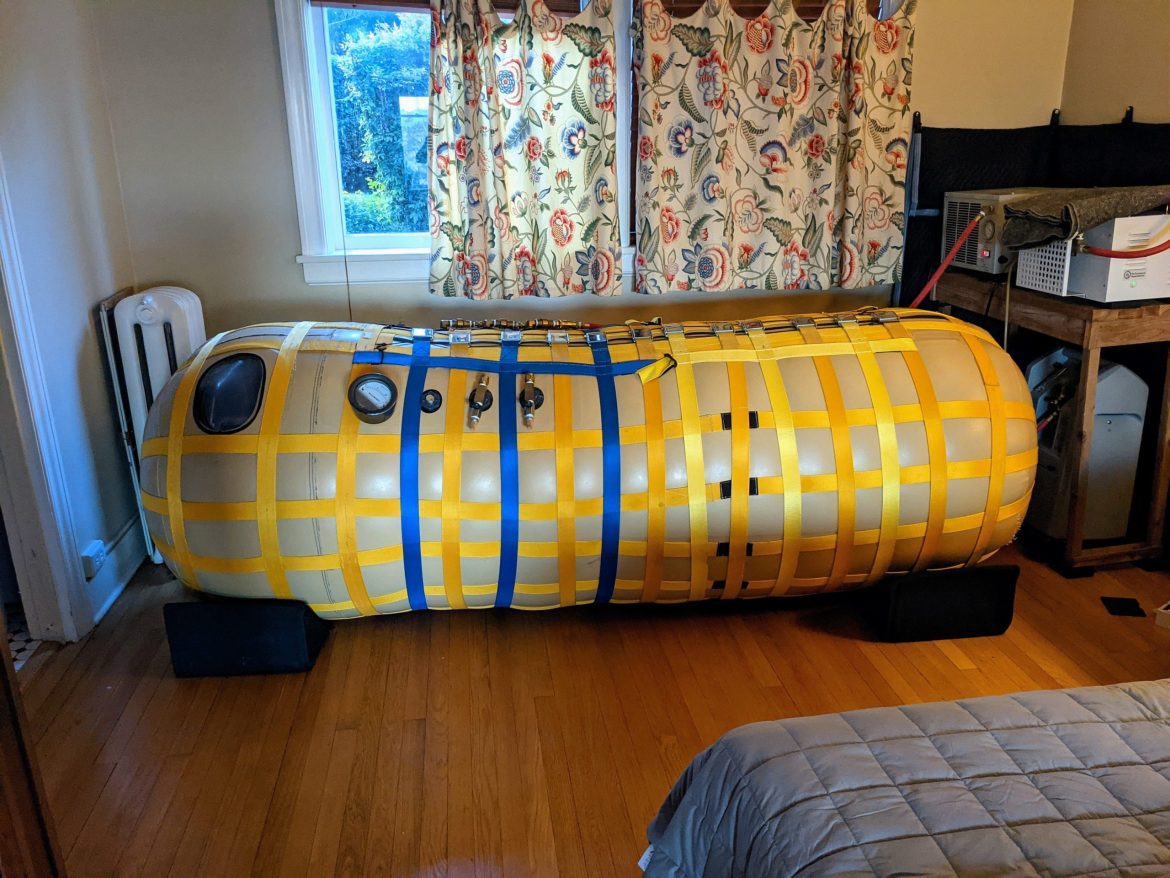When I read Dr. Thomas Seyfried’s studies on metabolic therapies for cancer and his “press-pulse” idea, I immediately knew it was right for me. The Press-Pulse strategy involves applying constant metabolic stress to the cancer and periodic “pulses” of acute stress.
Press therapies, for example, include a calorie-restricted ketogenic diet, ketone supplementation, and stress management like exercise, meditation, yoga, sauna, reiki, prayer, whatever does it for you.
Pulse therapies include glucose inhibition, glutamine inhibition, and other clinical treatments like Hyperbaric Oxygen Therapy (HBOT), Intravenous Vitamin C, etc.
Let’s talk about HBOT.
- Why Hyperbaric Oxygen Therapy (HBOT) for Cancer
- My Experience with Hyperbaric Oxygen Therapy
- Hyperbaric Chambers for Cancer: Types, Cost & Components
- HBOT Protocols for Cancer
- Frequently Asked Questions About HBOT for Cancer
Why Hyperbaric Oxygen Therapy (HBOT) for Cancer
Hyperbaric oxygen therapy (HBOT) is a treatment that involves breathing pure oxygen in a pressurized chamber. It has been used for a variety of medical conditions. In the case of cancer, HBOT is thought to work by increasing the amount of oxygen in the body’s tissues, which can help to fight off cancer cells. The idea behind this is that cancer cells are less able to survive in an oxygen-rich environment.
There is some research that suggests that HBOT may be beneficial for certain types of cancer, such as head and neck cancer, brain cancer, and breast cancer. However, the evidence is not yet strong enough to recommend HBOT as a standard treatment for cancer but evidence is accumulating.
- One study from 2006 published in the International Journal of Hyperthermia (“”Hyperbaric oxygen as an adjunct to radiation therapy for head and neck cancer”) suggests that HBOT can enhance the effectiveness of radiation therapy for head and neck cancer. The study showed that the combination of HBOT and radiation therapy resulted in better outcomes than radiation therapy alone.
- Another study from 2015 in the International Journal of Radiation Oncology, found that HBOT may improve the effectiveness of radiation therapy for brain tumors.
- There are also some studies that suggest that HBOT may be beneficial for breast cancer. A 2018 study published in the Journal of Cancer Research and Therapeutics found that HBOT may help to reduce the size of breast tumors and improve the effectiveness of chemotherapy.
Dr. Dom D’Agostino of the Department of Molecular Pharmacology and Physiology at the University of South Florida, is one of the leading researchers on the potential benefits of hyperbaric oxygen therapy (HBOT) for cancer treatment. One of the findings from Dr. D’Agostino is that HBOT may have an anti-tumor effect by
- Decreasing the acidity of the tumor microenvironment, which can make it more difficult for cancer cells to survive.
- Improving the effectiveness of chemotherapy by increasing the amount of oxygen in the tumor, which can help to make the cancer cells more sensitive to the drugs.
- Reducing the oxidative stress in the body, which is one of the key factors in cancer development.
Research is evolving and it’s important to note that the effectiveness of any therapy depends of loads of factors like the type of cancer, stage, your overall health, other treatments, etc. It’s always best to consult with your integrative oncologist about what’s right for you.
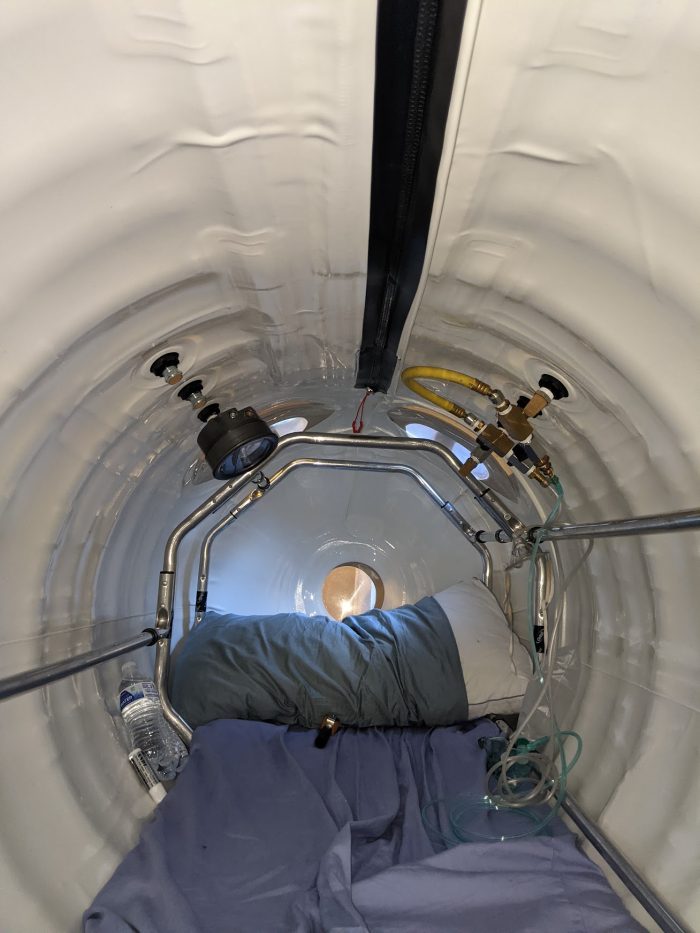
My Experience with Hyperbaric Oxygen
The first time I climbed into a HBOT chamber was in the first weeks after my diagnosis when I was desperately struggling to breathe. My lungs were filled with so much cancerous liquid that I was constantly coughing my death rattle cough and couldn’t even lay down for fear of drowning in it. I needed oxygen.
There was only one person in Hong Kong who offered HBOT. Brad and I took a taxi to his apartment and bumped into him smoking a cigarette outside the building. He took us up the elevator to his dark, cluttered, smoke-smelling studio and I spent an hour in his consumer-grade 1.3ATA chamber. I have no idea what the owner and Brad talked about for an hour. Whether or not it was placebo, I breathed much better after the “dive.” We were even able to take the bus home.
Brad rented me an oxygen concentrator after that.
I knew from the research that HBOT was helpful for cancer but, as my cancer seemed to be healing without it, it wasn’t worth going back to that creepy apartment.
All that changed when I developed brain radiation necrosis at the end of 2019. Unlike cancer, there is no “standard of care” treatment for brain radiation necrosis but HBOT is the standard treatment for other necrotic wounds caused by cancer treatment radiation – and studies indicated that HBOT can help in the brain much of the time.
All those studies, however, use 2.0ATA pressure or more. This would require a clinical chamber that wasn’t available at even the best hospitals in Hong Kong.
Brad was already planning to travel to London for his MBA in March of 2020, a city with plenty of high-pressure HBOT clinics. I took unpaid medical leave from my job in Hong Kong, sold all our furniture, put the rest of our possessions in storage, and Brad and I took a one-way flight from Hong Kong to London on March 22, 2020.
One day before their COVID lockdown started and all the HBOT clinics closed. Bummer.
But at the time, I only had one small lesion in my right cerebellum and was relatively symptom-free. Brad took his London Business School classes online and I waited for the clinics to open. When Brad finished his term, we looked for a less expensive place to stay and found ourselves in a small village in Austria thanks to dear friends with an empty summer house.
I had my first seizure in Vienna September 2020. After an emergency MRI, the poor doctors in the stoke ward explained in broken English how they were very sorry to tell me that I had tumors in my brain. I tried to explain that they were radiation necrosis lesions but I hadn’t recovered from the seizure and couldn’t say “big blue sky,” let alone “brain radiation necrosis from previous treatment.” In any case, I knew it was time to get serious about HBOT.
Brad and I spent the next month in Vienna strategizing on where to go. I knew I wanted pressure of at least 2.0ATA. Those chambers are legal for consumers in Austria but cost around US$60,000. Did I mention I’m on unpaid medical leave and Brad had just graduated? He was submitting dozens of job applications a week but $60k simply wasn’t an option.
We considered returning to London but we couldn’t be sure the HBOT clinics would stay open and London rent is pricey. Thailand has lots of clinics and affordable rents but the borders were closed. I’d always planned to go home to Hong Kong but there wasn’t a single chamber with the right pressure.
Above all, I didn’t want to go to the United States but that’s what the universe had in store.
I found a used chamber on ebay that someone had modified to 2.0ATA to treat his Lyme’s disease and was selling now that he had healed. My sister-in-law offered us her condo walking distance to my US cancer hospital and near my brother and his family. Everything aligned perfectly so that, days before the US 2020 presidential election, we moved to Seattle for what we thought was a couple of months. That was a little over two years ago.
Sweet Brad rented a car and drove from Seattle to Los Angeles to pick up the equipment and it’s been living in the dining room every since.
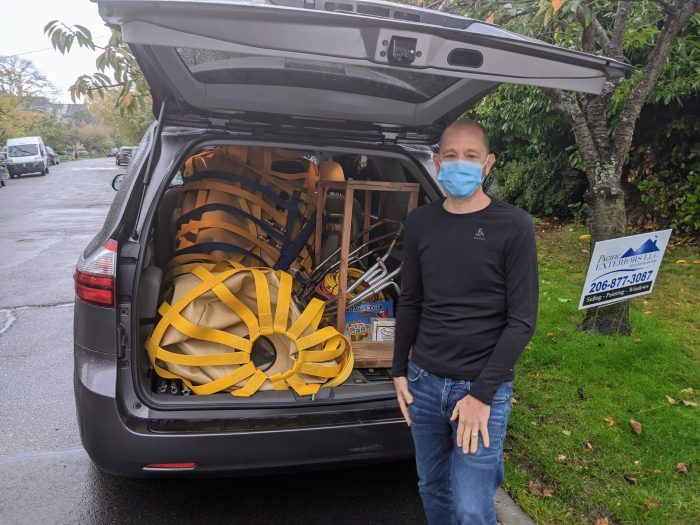
We’ve had some ups and downs with our used, modded chamber. At this point almost every part has been replaced or refurbished or both. We’ve certainly learned a lot.
Does it help?
Honestly, I don’t know. My doctors were almost hostility opposed to me trying it but, after a couple of scans, my neuro-oncologist actually documented in his clinical notes that HBOT was contributing to my doing so well.
There’s so much that goes into my healing: diet, stress management, exercise, mindfulness, meditation, positive thinking, off-label drugs, HBOT, sauna… I’m not doing a randomized, cross-over, placebo study with this.
My best guess, based on timing, is that HBOT was the biggest contributor to stop the advance of my radiation necrosis but obviously hasn’t healed it. For cancer, I’m guessing it’s helpful but not necessary to continue healing. Overall there are so many benefits to the body, I’m grateful I have the chamber.
Hyperbaric Chambers for Cancer: Types, Cost & Components
The pressure required for hyperbaric oxygen therapy (HBOT) to be beneficial for cancer treatment varies depending on the type of cancer and the stage of the disease. In general, the pressure used in HBOT for cancer treatment is typically around 2 to 2.5 atmospheres absolute (ATA), which is equivalent to about 30 psi (pounds per square inch). This is slightly higher than the pressure used in HBOT for other conditions such as decompression sickness and wound healing, which is typically around 1.5 to 2 ATA.
HBOT Chamber Types & Costs
HBOT chambers that are available to consumers are typically portable, single-person chambers. They are designed to be used in a home setting and are smaller in size than the multi-person chambers used in hospitals and clinics. They generally only pressurize up to 1.3 ATA (19 psi).
If you’ve decided with your healthcare team that HBOT is the right therapy for you, you have the option of visiting a clinic or investing in your own chamber.
Clinics
The price for Hyperbaric Oxygen Therapy (HBOT) treatment at a clinic can vary widely depending on a number of factors, such as the location, the type of chamber used, and the duration of the treatment.
On average, a single HBOT treatment session can cost anywhere from $200 to $500, but the cost can be higher depending on the facility and the length of the treatment. A package of 40 sessions can cost around $10,000 – $20,000.
Many insurance companies do not cover the cost of HBOT – especially since it’s not an approved treatment for cancer. Facilities might offer financing options.
Home Chambers
The highest pressure chamber available to consumers in the US is typically limited to 1.3 ATA (19 psi). This is the maximum pressure that is generally considered safe for use in a home setting and is also the maximum pressure that is approved by the U.S. Food and Drug Administration (FDA) for use in portable, single-place chambers.
Some 1.3 ATA consumer chambers available in the US include:
- The Oxyhealth Vitaeris 320
- The Sechrist Industries Hyperbaric Oxygen Therapy Chamber:
- The Hyperbaric Oxygen Therapy Medical Chamber
Generally these consumer chambers run about US$10,000-$20,000. HBOT USA is a great company whose owners I know and love.
While 2.0 ATA pressure chambers aren’t generally available to consumers, there are workarounds. It’s possible that someone in the household could train and certify as a HBOT operator or to modify an appropriately re-enforced chamber like mine. With the latter, you risk running afoul of the FDA. Just don’t tell anyone about it on your blog or anything dumb like that.
My official recommendation for having a higher pressure chamber at home includes:
- Consult with a licensed healthcare professional: Before attempting to use a higher pressure chamber at home, it is important to consult with a licensed healthcare professional to determine if it is safe and appropriate for your condition.
- Obtain a prescription: Many higher pressure chambers require a prescription from a licensed healthcare professional in order to use them.
- Training: Some manufacturers of higher pressure chambers may provide training on the proper use and maintenance of the chamber. It is important to follow the manufacturer’s instructions and any additional training provided by a licensed healthcare professional.
- Certification: Depending on the regulations in your area, you may be required to be certified in order to operate a higher pressure chamber at home.
- Compliance with regulations: It is important to comply with any regulations that apply to the use of higher pressure chambers in your area, including obtaining any necessary permits or licenses.
Generally, these higher-priced chambers are around US$45,000-$60,000. Used is considerably less expensive. I purchased mine super used on eBay for $14,500 but have since put in around $20k in repairs and component replacement.
If you decide to go this route, I try to act as a clearing house for used high-pressure chambers so feel free to email me.
Components
An Hyperbaric Oxygen Therapy (HBOT) chamber typically includes the following components:
- The chamber itself: This is the pressurized vessel that the patient will sit or lie in during the treatment. It can be made from a variety of materials, including steel, aluminum, or plastic, and can be either rigid or flexible. For me, I have an inner chamber (super airtight) and an outer chamber (that holds it together).
- Oxygen source: This is the source of pure oxygen that is delivered to the patient. It can be delivered through a hose or mask, and the oxygen is usually pressurized to match the pressure inside the chamber. I have 2 portable oxygen concentrators and use a non-rebreather mask. A special O2 concentrator with a high pressure is needed.
- Pressure control system: This controls the pressure inside the chamber and maintains it at the desired level. It usually consists of a compressor and a pressure gauge.
- Lighting and ventilation: HBOT chambers usually have a lighting and ventilation system to provide a comfortable environment for the patient and to prevent the build-up of carbon dioxide inside the chamber. No matter what your cost concerns, do NOT forgo A/C. Take it from me.
- Bonus: I recommend sound-proofing if your neighbors are nearby.
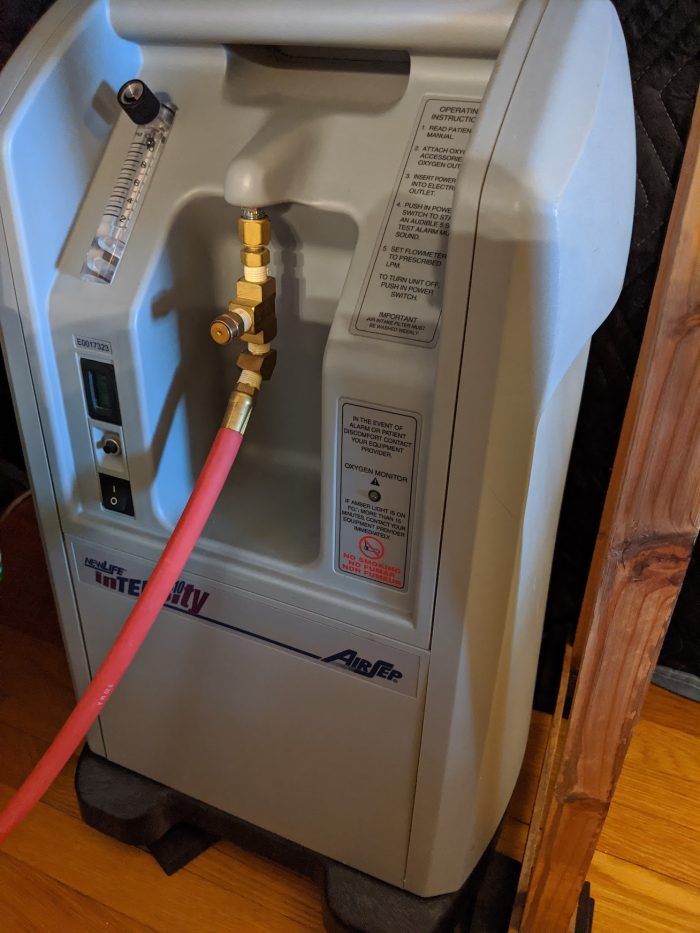
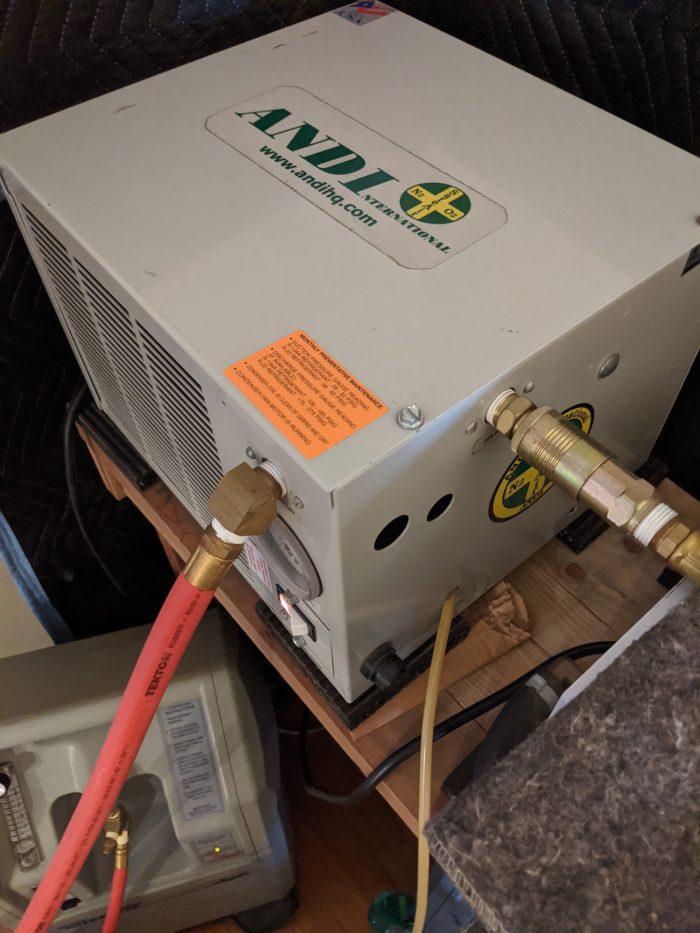
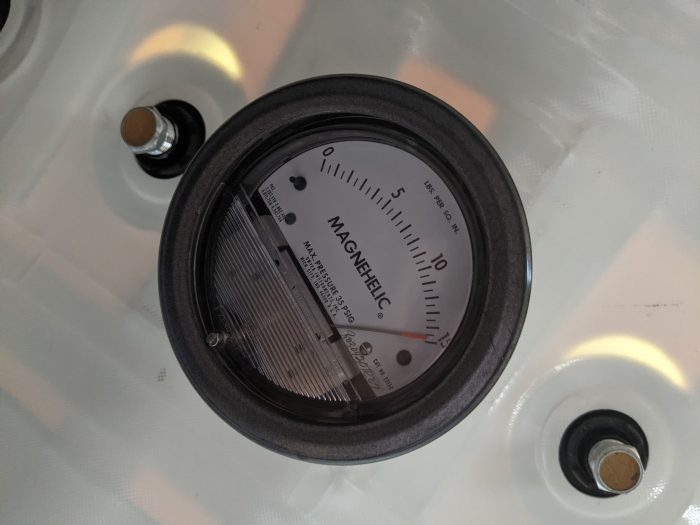
HBOT Protocols for Cancer
The most common protocol for treating cancer is to provide treatment at 2.0 ATA or above for 60 to 90 minutes, with treatments repeated up to five times a week, for several weeks.
As a person suffering from brain radiation necrosis, it’s worth noting that most common protocol for treating non-healing wounds is 40-80 dives at 2.0 to 2.5 ATA for 60 to 90 minutes.
Personally, when I’m in the chamber, I breathe oxygen through my non-rebreather mask for 20-25 minutes, followed by 5 minutes without the mask, then repeat. This helps to
- reduce my in-chamber seizures (and I have a seizure about 80% of the time I’m in there. I’m like one of Pavlov’s dogs twitching in anticipation of a shock every time I get in there now.)
- simulate hypoxia, good stress like a cold shower (I read this idea in a study but I can’t find it now.)
Note: my seizures are super mild and I feel in control of when I can dive. If you get a seizure, HBOT isn’t for you but you can still breath concentrated oxygen.
I use a free app called “Interval Timer” and my standard session (if it’s not cut short by too many seizures) is
- 20 minutes to compress
- 25 minutes with mask on
- 5 minutes mask off
- 25 minutes mask on
- 5 minutes mask off
- 25 minutes mask on
- 5 minutes mask off
- 25 minutes mask on
- 5-10 minutes to decompress
Yes, it’s a long session but a great chance to meditate and practice my Buteyko breathing or other pranayama during my mask off breaks. Brad likes to watch shows on his phone on the very rare occasion he has time to dive.
Other Frequently Asked Questions About HBOT for Cancer
What are the dangers or side effects of HBOT?
HBOT is generally considered safe but, like any medical treatment, it can have some rare side effects. These side effects can range from mild to severe but are usually mild and temporary:
- Ear and sinus pain as a result of the pressure changes in the chamber. Pop your ears throughout compression and decompression.
- Fatigue. Some people – like me – might feel pooped after treatment.
- Transient myopia, temporary near-sightedness, during or after treatment. I usually have blurry vision for a day or so after each dive.
- Oxygen toxicity. In rare cases, some people experience seizures or lung injury due to high levels of oxygen – even people who’ve never had seizures before. This is the best argument I can think of for starting your HBOT journey with trained professionals. It’s the least common but most dangerous side effect.
- Claustrophobia. This doesn’t affect me; it’s way more roomy than an MRI tube.
- Barotrauma, injury to their lungs or ears, due to pressure changes in the chamber. I simply won’t dive if I have plugged up ears.
Again, good reasons to work with professionals.
Can I use my phone in the chamber?
Unless you’re using a hard core medical chamber that completely fills with pure oxygen, yes. Every chamber I’ve ever seen uses a mask to deliver the oxygen. The chamber is filled with regular air so you can bring all your electronics: phone, noise-canceling headphones, kindle, flashlight, laptop, whatever.
What about a catastrophic blow out?
I used to catastrophize about this when I first started my HBOT adventures but nah. In the past 2 years I’ve sprung loads of leaks (some of which I patched with cling wrap and tape until I could afford a new inner chamber) and holes (for which Brad did everything he could to keep the outer chamber together). Only after breaking a strap mid-dive did I stop using it until I could afford a new outer chamber.
At this point, I don’t see how a catastrophic blow out is possible in a soft-sided chamber. However, if I were to get into a situation where I couldn’t decompress at my leisure, I’d probably visit my local emergency dive location to be monitored for the bends.
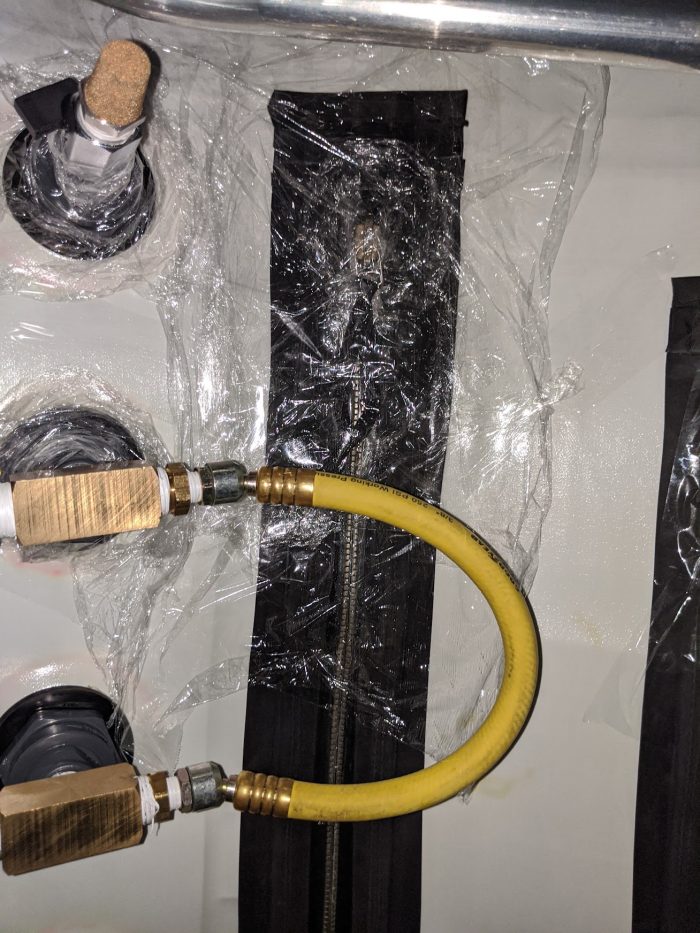
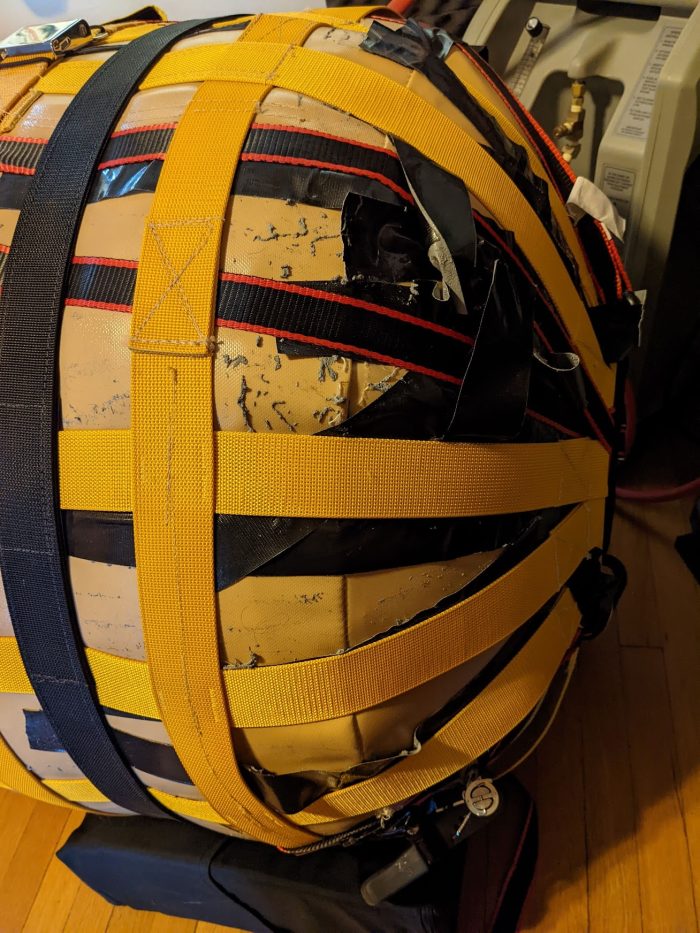
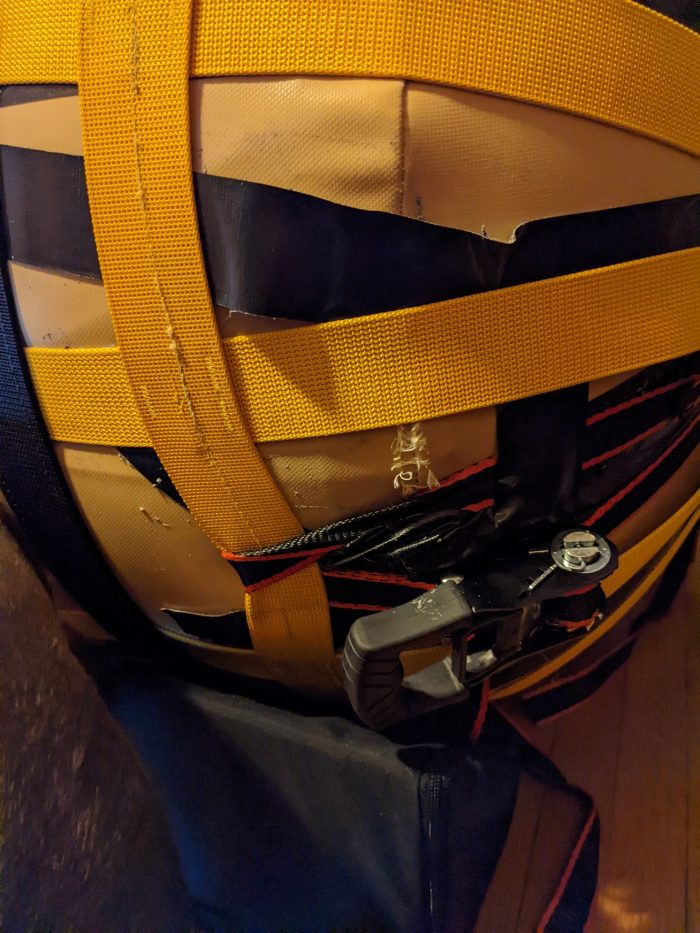
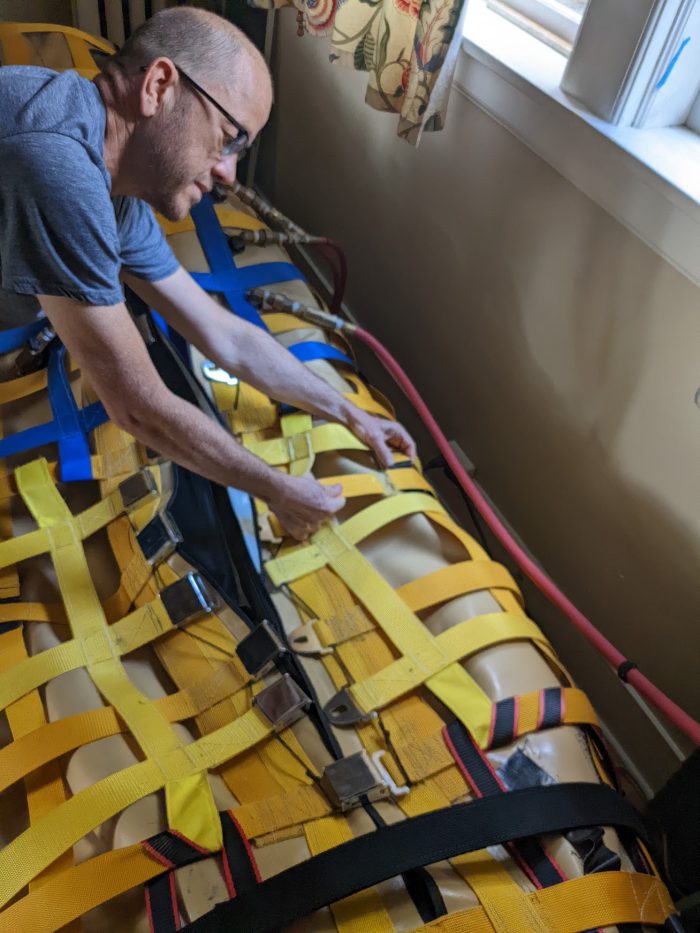
What’s the difference between ATM and ATA?
Ugh. There’s not really. ATM is atmospheres and ATA is atmospheres absolute. I usually use ATM out of habit but ATA is probably more correct. I’m sure I’ve confused you with using both here.
What’s up with your spelling?
I haven’t used my chamber in a while and my language skills are the first functionality to go. Sorry!


